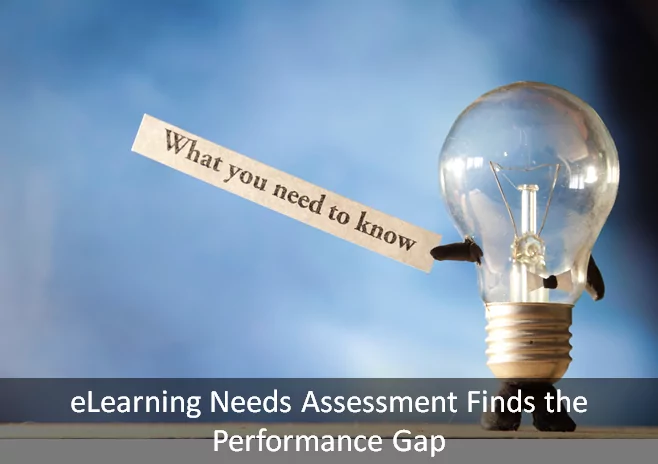The Art of Needs Assessments in eLearning

In a previous series of articles about evaluating eLearning, I noted how important it is to align eLearning goals with organizational goals (see Level 4 Evaluation for eLearning: Results). The six steps involved in that process include clearly defining performance goals, identifying the tasks that will achieve the goal, determining learning needs, prioritizing learning needs, developing learning content and delivery method, and implementing and tracking results. In this article I will hone in on that third step of the process – Determine learning needs.

You already defined what the business challenge or issue is – there is some desired level of performance that is not currently being met. The eLearning needs assessment is how you go about figuring out what’s behind the performance gap. You’re looking for what’s causing that gap. If the work were manual labor, you could go about this by just observing people engaged in the work to see what’s happening. When the work is not of that nature, you need to put on your Sherlock Homes sleuthing hat to figure out what’s standing in the way of the desired performance. And that’s going to involve talking to people.
Talk to the people who have to perform the tasks that lead to the performance goal and find out from them what’s needed to take them to the next level. Maybe it’s a particular skill they’re lacking, or key bit of knowledge. Maybe there are significant organizational or managerial barriers that hold them back. Assessing the needs that your eLearning efforts will address is an essential part of the overall process. As you talk to people try the following three strategies:
Get Radical with Root Cause Thinking
You want to discover the root cause of the performance gap, realizing that there may be multiple root causes. The word radical itself comes from the Latin word for root, so I ask you to get radical in order to find the root cause. There’s a gardening metaphor here as well – if you merely chop off the top of a weed, it will come back, you have to pull it out by its roots to really eliminate it. Conducting a thorough analysis to get to the root(s) of a problem will take time. Be willing to put in your best effort at this stage because the payoff is huge.
Use Journalistic Questioning
Knowing how to ask the right questions will lead you to quicker, more accurate insights. Leave no stone unturned by asking the 5W+H questions as follows:
- What happens?
- Who is involved?
- Where does it happen?
- When does it happen?
- Why does it happen?
- How does it happen?
Ask WHY Five Times
The Five Whys method can also lead to deeper understanding. Five is just one rule of thumb, but it often bears out that by the time you get to the fifth why, one or more root causes will be revealed. Sometimes it may take more, sometimes less. Each time you ask why, pay attention to what is revealed and determine whether or not eLearning can play a role in addressing it. Don’t take this method too far or it becomes counter-productively annoying.
If you ever wanted to be a detective when you were a kid but find that you’ve become a learning professional instead, here’s your chance to combine the two. Conducting a thorough eLearning needs assessment will ensure that you get to the root causes that your instructional content must address.